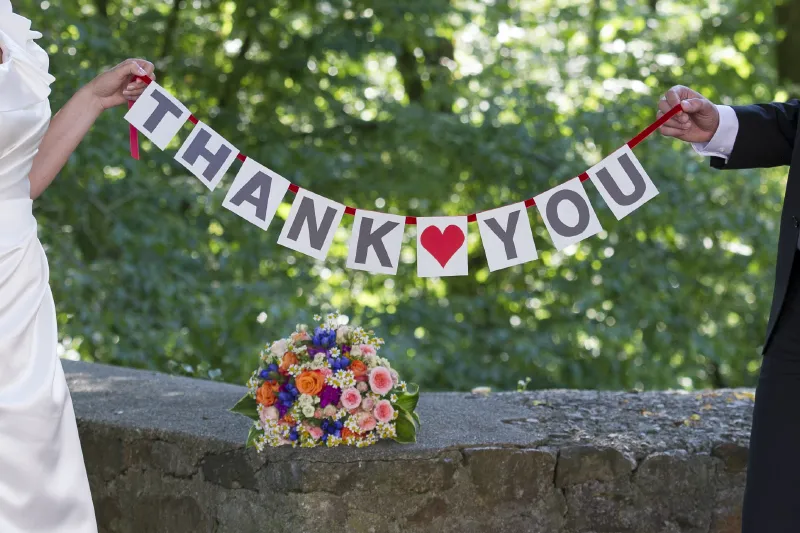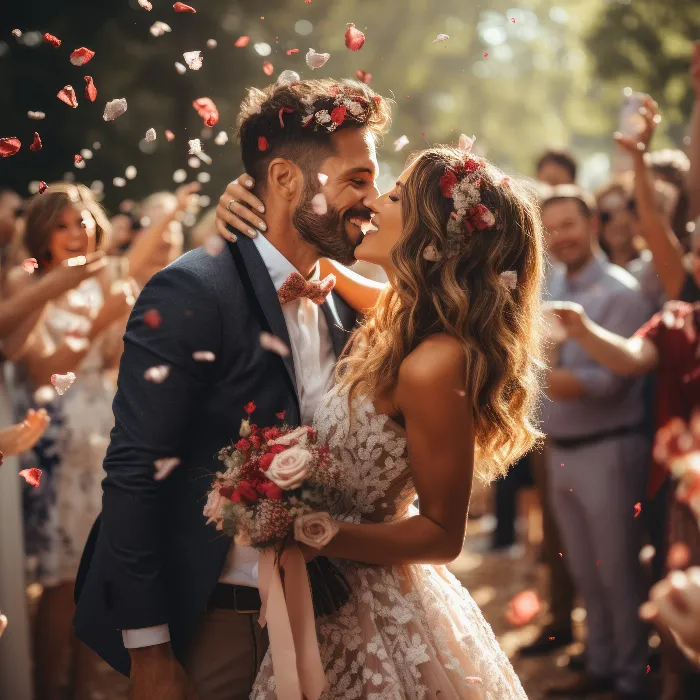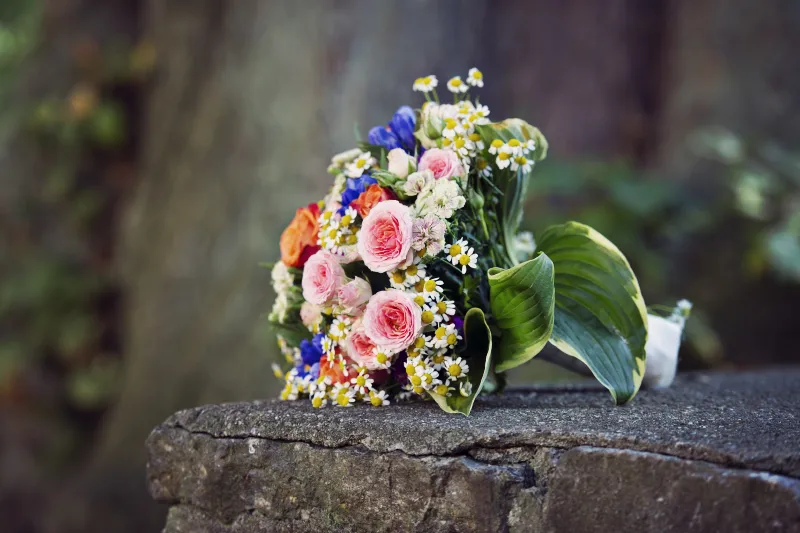
Introduction:
Good equipment for a wedding photographer is of course very expensive. First and foremost, I actually want to give some tips here to beginners and amateur photographers who enjoy covering a friend's wedding from the second row here and there. This can be a new idea for a shooting angle, a bit of confidence to break new ground and the certainty of finding a happy bride and groom at the end of their work if they have thought of everything.
I am well aware that you are not going to buy thousands of euros worth of equipment for this. But perhaps you have already created a good basis with your existing equipment and would like to save on one or two things in order to expand it. Maybe even with the main focus on weddings, if that's what you enjoy. You're sure to find some great ideas for this, even on a budget. And maybe one or two of you really will soon take the next step and, after gaining a lot of experience, will soon want to bring wedding photography to the bride and groom professionally ...
In this introduction I would like to start by introducing my equipment, as a little orientation. I will describe how I use it in the following tutorials in this series! Here I will also provide information on the camera settings used and the exact technique.
Let me start by saying that I don't work with an assistant, but always attend and photograph weddings on my own. I don't use a portable studio for my reportages and I don't use any reflectors. This means that I work exclusively with daylight and only if it can't be avoided, with a clip-on flash and possibly a second tripod flash. This allows me to do without an assistant. Nevertheless, I have also made a few comments on this.
Since I'm not a brand advocate, I don't want to hear any nasty voices. I am a Nikon photographer. Why? Because I learned and started with it and a change would simply be too expensive. Furthermore, I don't have the reasons to switch, so I'm very happy with this choice. Nikon and Canon are the biggest manufacturers in this field. After many conversations with other photographers, countless discussions and, of course, self-study with various Canon cameras, I was able to recognize advantages and disadvantages on both sides.
In general, however, I am not someone who says that my camera brand is the ultimate. And I don't want to hear that from Canon photographers either. If you want to buy a camera, you should simply pay attention to what is important to you and ONLY choose your camera according to what brand it will end up being.
I'm currently working with the Nikon D4, although the photos in this tutorial series were all taken with the D3s. I am very happy with both cameras. After some initial difficulties, I have not regretted buying my D4. Even though the D4s is coming soon. The only drawback of the D3s - for me personally - is the low number of megapixels (12 megapixels). That's one of the only reasons in favor of Canon. On the other hand, the Nikon is fast, which is not decisive for wedding photography, but for sports and animal photography, for example.
For weddings, of course, the number of megapixels doesn't bother me. However, as I occasionally need larger images due to image sales and working with agencies, I bought the D800 for advertising shots, which with its 36 megapixels is doing its job today.
It allows me to crop the images - which is sometimes necessary - without having to hand over image data that is too small. Apart from advertising shots, it is perfect for sensational landscape shots (especially HDR) and macro photography. We use it for this almost every day. We've also been using it to test wedding videos for a few months now and we're really impressed with the quality.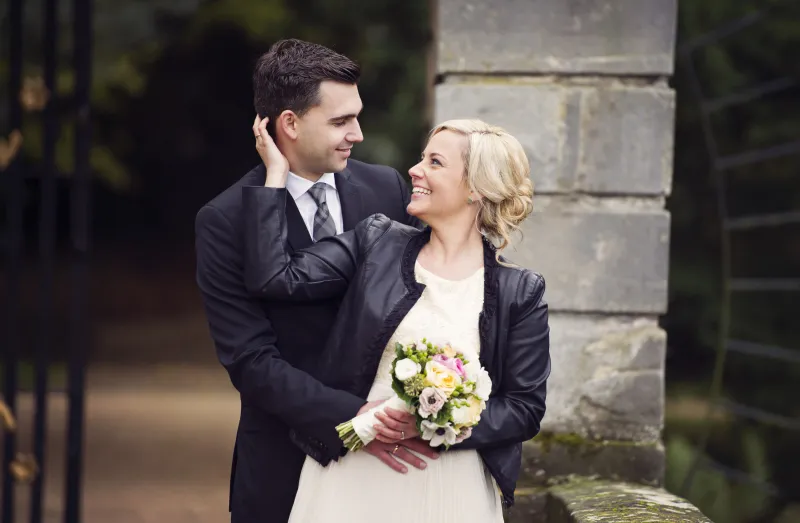
I think the Nikon D800 is only suitable for wedding photography to a limited extent, as it simply needs an incredible amount of memory, unless you want to shoot in the impractical DX mode.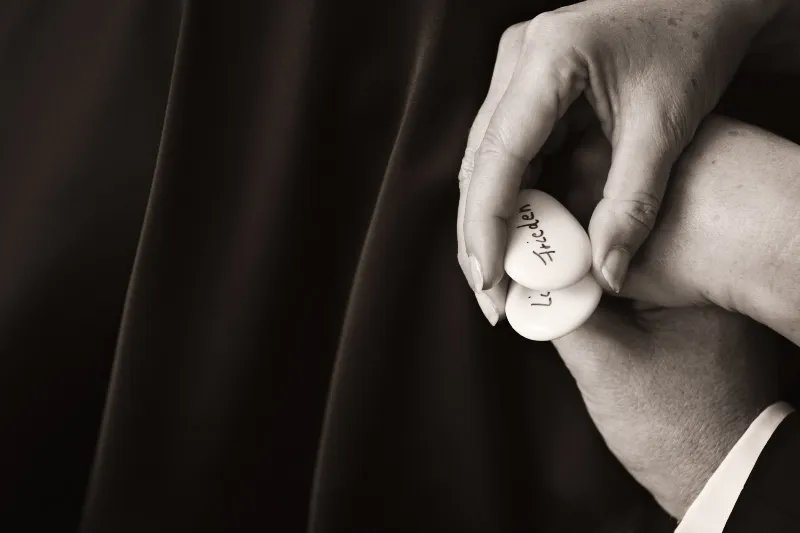
Of my lenses, the following go into my equipment bag when I go to weddings:
- Nikon 14-24mm f/2.8G ED
- Nikon 24-70mm f/2.8G ED
- Nikon 70-200mm f/2.8G ED VR II
- Sigma 105mm 2.8 EX Macro DG OS HSM
- Sigma 15mm F2.8 EX DG Diagonal Fisheye
There are still many lenses that would be used if I could have afforded them! I'll give you a few more recommendations later under lenses. Unlike a photographer who specializes exclusively in weddings, I have to cover all areas. I still have a few fixed focal lengths for children and baby photography and two large telephoto lenses for animal photography.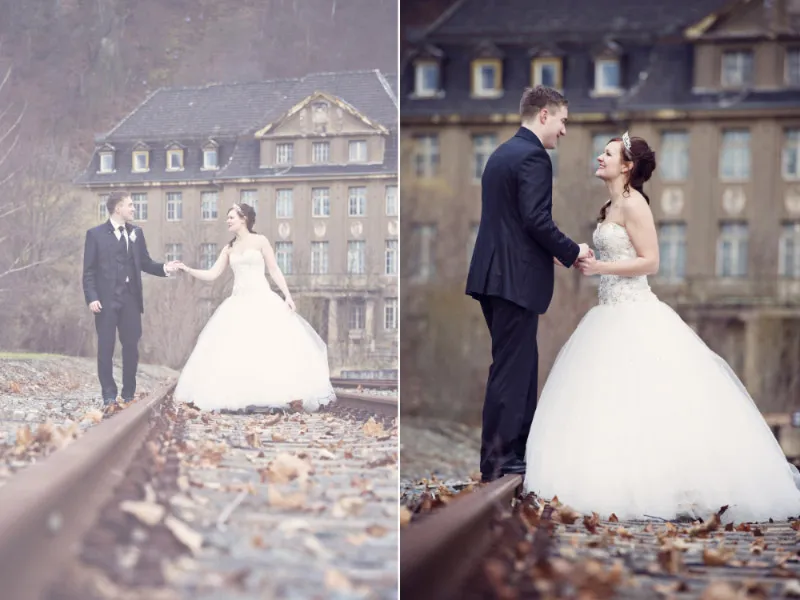
I also currently use the Nikon SB-910 as a clip-on flash and the SB-900 as a spare flash. With the SB-900, it should be noted that it runs "hot" and then switches off automatically. This can be switched off in the menu and it is advisable to do this before a wedding, otherwise it will stop working for about 3-4 minutes, which feels like 15 minutes. This often happened to me, for example, when I wanted to quickly photograph 120 guests at a party one after the other and a flash was essential for this or when I took many photos in a row in the church at a wedding or christening without longer breaks.
But now I don't want to present my equipment any longer, let's get down to business. I would like to touch on the following points in this tutorial on wedding photography "Equipment and gear":
1. camera
The question here is of course: Do you already have a camera that you want to use at weddings and don't know whether it's suitable? Or would you like to buy a camera and want to know which one is the best choice for weddings within your budget? This question is not so easy to answer. There are simply too many models on the market and the only important thing is the different criteria. I would also say that almost every camera will take the right pictures with the right handling and eye of the photographer.
Conversely, even the most expensive and best equipment will not be able to help someone who lacks the right eye for photography. I would therefore choose a camera that meets the following criteria (and bear in mind that the lenses play an important part in your purchase). You should therefore consider how best to allocate your available budget.
- Autofocus
Fast autofocus is important. Of course, there is an extreme difference between inexpensive and large models. For wedding pictures, a fast and precise autofocus is of course indispensable. Here it is really important to purchase the best camera model with the best possible autofocus, depending on your budget. Of course, this is an interplay between camera and lens.
- ISO
Of course, it is usually the case that the cheapest cameras produce the most noise at high ISO values. But cameras are getting better and better these days and it's likely that a bride and groom who are happy to have beautiful shots won't notice how much noise there is in an image. I also have trouble making sense of the test images from the big cameras. For example, I see test images from the D3s and D4, which didn't exactly encourage me to switch to the D4, and I can hardly tell the difference. However, photographers in the field say there is a significant difference. I would like to repeat here that the ISO noise is different for every photographer and every viewer of the photo and you also have to find your own pain threshold here (depending on the subject). Nevertheless, it should of course always remain within limits and a good camera is more forgiving of high ISO values than a smaller model.
Photographing a dark church without flash: High demands on light intensity and ISO.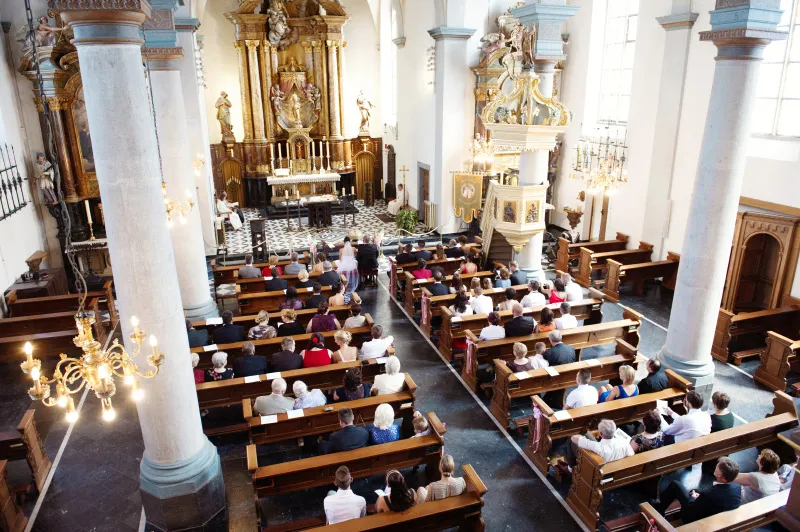
- Megapixels
Very small camera models sometimes also have very low megapixel numbers. I would perhaps make sure that you get around 12 megapixels. There are also small models, like my first camera, which only had 6 megapixels. Especially if you're cropping photos, it could be a bit tight for your bridal couple if they want to make large-format prints from your photos. You shouldn't limit yourself too much. But it's not a case of the more, the better. It doesn't have to be too much!
- Speed
In my opinion, speed doesn't play a major role in wedding photography. You don't really need to focus on shots per second here.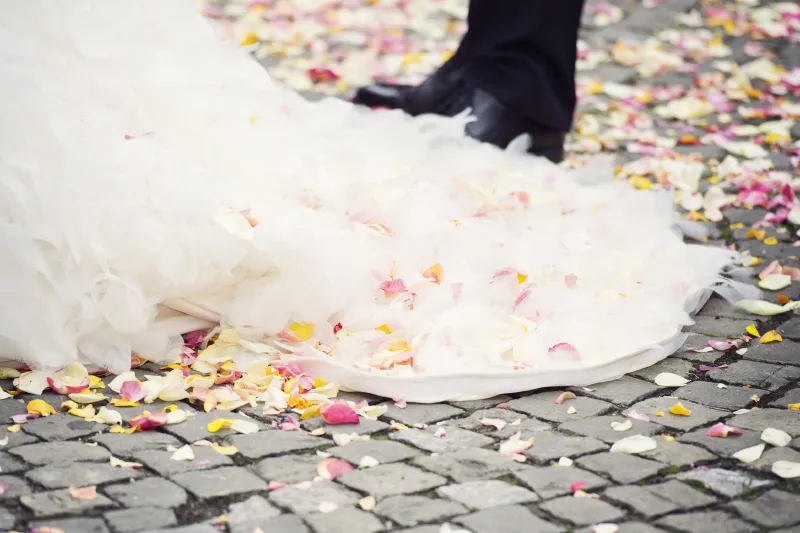
- Memory card slots / double backup
Of course, it's great if your camera comes with two memory card slots. That way you can make a double backup when you're taking photos at a wedding. Nothing has ever happened to me, I've never had a total memory card failure and I've never lost any photos. But better safe than sorry. I keep hearing about such cases. Wedding photos should never be lost! So if it's possible, see if your camera can do this when you buy it. Or have a contingency plan for emigration ready .... I never want to have to teach this to a bride and groom.
Otherwise, I don't want to list any models here. I would advise you to choose the best possible camera for your budget according to the above criteria. I would cautiously say that if you are a hobby photographer, you should estimate 800-1,000 euros for a camera that is really good enough for good wedding photos, and of course more if possible. You can always go higher, it's not forbidden to work with smaller models, but if you want to offer your wedding photos for a fee at some point, then you should think about buying better equipment.
When I started out in photography, most professional photographers around here had a Canon or Nikon camera that cost around 2,000 euros, and usually the same model as a backup. That was also my D700 back then. When I saw wedding guests standing next to me at three weddings in one year with the D3 hanging around their necks, I got tired of the shame and bought the D3s. Nowadays, many hobby photographers who have the necessary small change have very good and expensive cameras. Of course, this says nothing about the quality of the pictures, because after all, it's the photographer who takes the good picture, not just the camera.
But as a professional photographer, I was infinitely embarrassed that I myself had a smaller camera than the amateur photographers at this wedding. I don't know how other photographers deal with it, but that was the main reason for not wanting to stop here, and I think every photographer has to upgrade their equipment at some point. Of course, the D3s was a significant and big improvement in every aspect. I have never regretted the purchase, but I have never held my D700 in my hands again.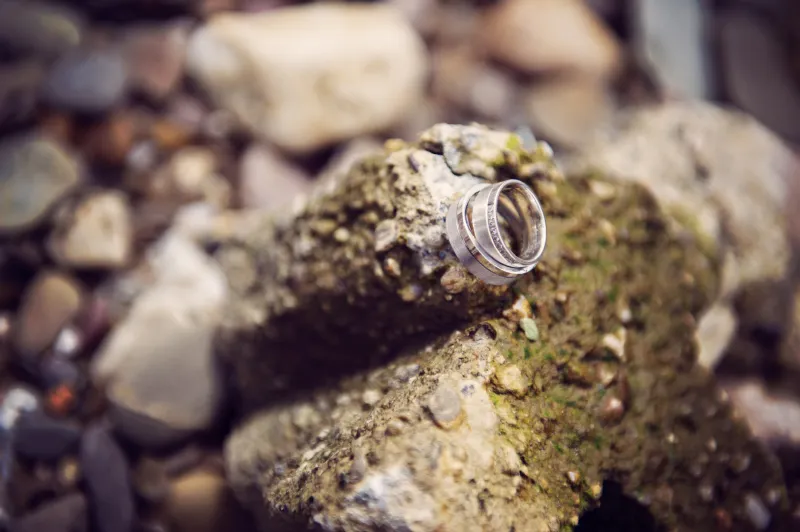
Full format: yes or no
The question of full-frame format (with Nikon FX) is of course often also one of price. Full-frame cameras are usually more expensive than cameras with an APS-C format sensor (with Nikon DX). The switch to full-frame format was not easy for me and perhaps needed to be practiced a little. Not only were all my long focal lengths suddenly "gone". Of course, your depth of field also changes. Where an open aperture of 2.8 used to be perfect, I might now need an aperture of 4.
It will take a while before you can correctly assess the new distance to the subject and the respective depth of field again. I've always appreciated the advantages of the crop factor, especially when I switched to full-frame format and really became aware of them. Today I still miss it and am actually considering buying a DX camera again. Just for me, to enjoy. Like everything in life, it's a question of taste.
2. lenses
- Shorter focal lengths
The tiresome subject of lenses. It's not the camera alone that is decisive, but the optics. It hurts that good lenses usually correspond to the price of a new camera. This is precisely why you need to plan well which lens you are going to buy. Where do you have deficits, what is indispensable, what can you buy later? As you certainly can't just buy lenses with a f/2.8 aperture, you should see where you can save a little money so that you can buy all the lenses you really need.
For example, I recently read in a good photography book about weddings that a photographer shot an entire wedding with a 50 mm lens. This Nikon lens costs around 400 euros if you want it with Blender 1.4. In DX format you even have an 85mm, but then of course you lose megapixels again. I also don't like shooting in DX format with a full-frame camera. But perhaps that's also a matter of taste.
Shorter focal lengths make it possible to capture the whole scene.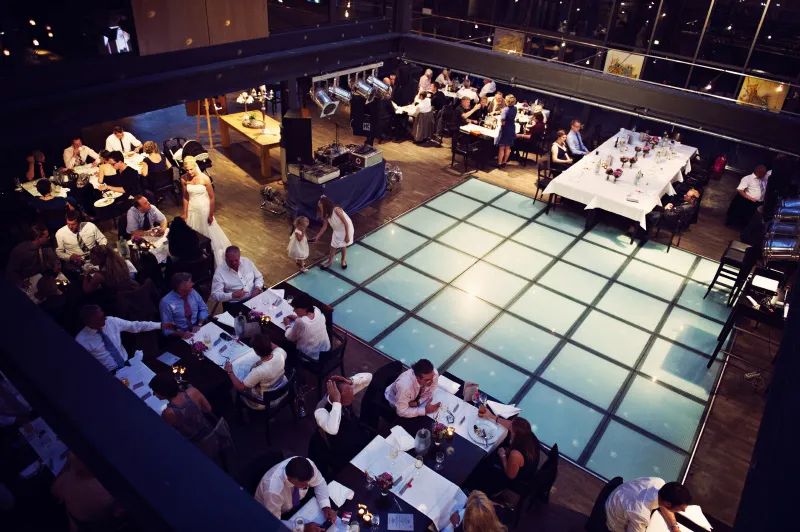
A fisheye lens. A gimmick or essential for a photographer's creativity?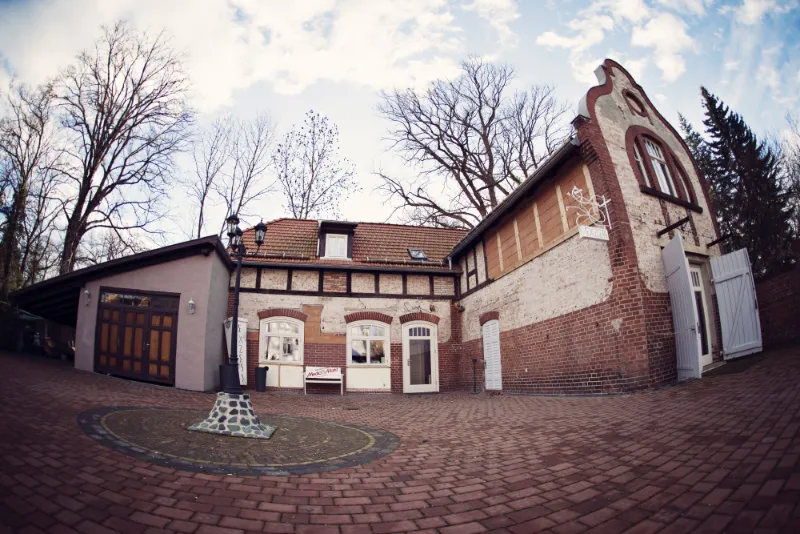
- Longer focal lengths
In general, you should make sure that you have at least one lens that covers a small focal length, regardless of whether you're using full or DX format. 50mm would be great, 24mm better. That way you're always on the safe side. Which one it will be and whether zoom or fixed focal length will be decided by your wallet.
Consider the following task, for example: 120 guests in front of a church/registry office with little space "to the rear" to gain space. As you can't stack them on top of each other, it can get tight! If necessary: borrow a lens at the beginning, it's better to take too much than too little. The more you can cover, the easier it will be for you and the less stress you will be under. Then, of course, it's nice if you have a telephoto zoom lens that allows you to do "more". Especially,
1) if you want to take snapshots of the guests without being "noticed",
2) if you have to/can stand further away from the couple in the registry office or church,
3) if you want to take couple photos as flexibly as possible during the reportage, e.g. photos in motion (couple coming towards you etc.) and a fixed focal length would restrict you too much.
Even so, you will always find opportunities where a nice telephoto lens will help you. I love my 70-200mm and I wouldn't want to be without it. Of course, opinions differ when it comes to quality, as many photographers swear by fixed focal lengths, but I personally don't want to be limited by this - and you are always limited with a fixed focal length! And at a wedding, I want to be as flexible as possible. What happens in front of you cannot be planned, cannot be predicted in detail, cannot be repeated.
So don't limit yourself too much with fixed focal lengths, especially at the beginning. When you have gained experience later and can be sure that one lens or another will cover 100% of your work, then that's another matter. Initially, I would always play it safe.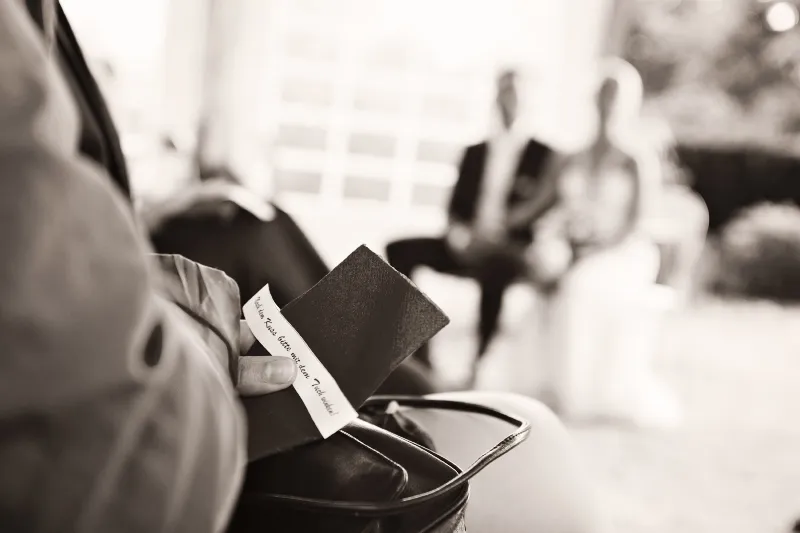
The main reason (for me!) for a telephoto lens: you can work away from the action. This allows you to work discreetly and sometimes catch beautiful snapshots unnoticed.
The main reason (for me!) for a zoom as opposed to a fixed focal length: You don't have to move around as much. Especially at the wedding ceremony, it's important to work "invisibly". You shouldn't have to walk back and forth too much! With the right zoom lens, you can be mobile without having to move your feet.
However, I don't want my opinion to be the only one here. Other photographers often recommend using fixed focal length lenses, which are cheaper than fast zoom lenses, for your first equipment - in favor of speed. In my opinion, this is a matter of taste. But everyone should have tested beforehand how well they can work with a fixed focal length and how often they might have to change lenses at a wedding.
In my opinion, this requires a lot of experience, because a newcomer won't always know which fixed focal length they really need to use in which situation. But this is a matter of taste and I think that this point should not go unmentioned here. If someone swears by fixed focal lengths and is experienced, then this may be the better choice for them. For me, this was never an alternative, and I have already listed the reasons for this.
If you don't have enough money, then look for good alternative lenses, e.g. from Sigma or Tamron. It doesn't have to be an expensive Canon. The price differences here are sometimes considerable and should be weighed up. Quality or not. Of course, it hurts if you initially buy a Sigma for cost reasons and later replace it with a Nikon or Canon lens. Nevertheless, it is also worth reading test reports, because one or two lenses from a third-party supplier sometimes perform better than the original.
Nevertheless, these lenses are good and will be of good use to you in the beginning or even be your permanent favorite. Also look for used lenses. Here, too, you can save a lot of money and buy a few treasures for little money. Of course, there is always a residual risk involved, but sometimes you have to be a little lucky. You can expand your stock of lenses over time. Initially, you may have to make a few compromises for your wallet.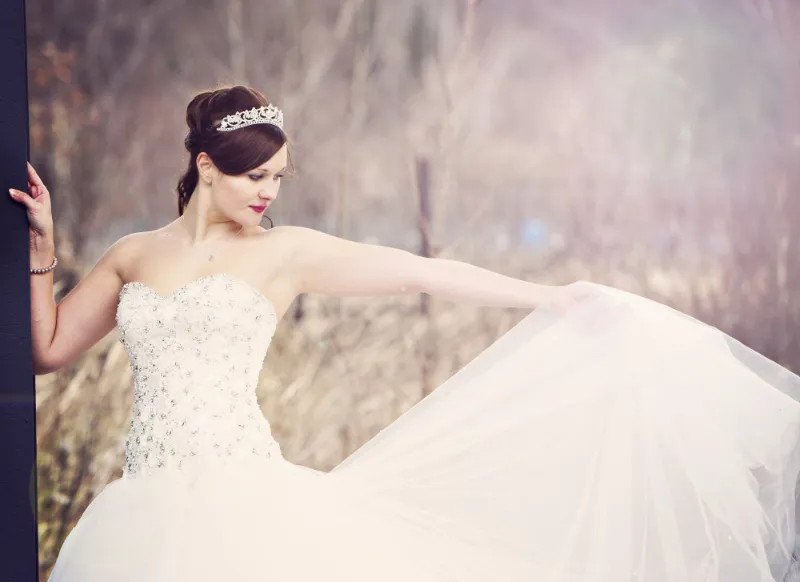
The more money you have at your disposal, the more you can go for light intensity and branded lenses. Incidentally, opinions differ here. Some swear by their Tamron or Sigma lenses, other photographers shoot almost exclusively with the lenses of their camera manufacturers.
3. flash / reflector / mobile studio flashes
Of course you should always have a flash with you! Also - if possible - a second one in case the first one lets you down. This doesn't happen often, but it can't be completely ruled out, as I described in the previous tutorial. You could also get yourself a diffuser attachment. There are now many different versions available for little money and it's worth trying out one or two!
As already mentioned, I work alone and therefore without reflectors and I also don't use mobile studio flashes. For me personally, there are many reasons for this, apart from the high purchase costs, if you value good quality equipment. A Porty and mobile studio flashes,
- take up a lot of space during transportation
- are heavy and have to be taken into account when it comes to mobility
- usually require an assistant who wants to be paid
- have never really been necessary for me.
Nevertheless, I mention it because many professional photographers work with it for a reason and attach great importance to it. You personally might not work with it at first, it's not like it's a MUST, but you might get to the point where you want to try it out or set up your equipment for it. If you have an assistant, all the better. In the beginning, I really recommend the rental service that the manufacturers of such equipment usually offer. Try it out in practice at a nice location and get to know the advantages of such equipment.
It only works with daylight!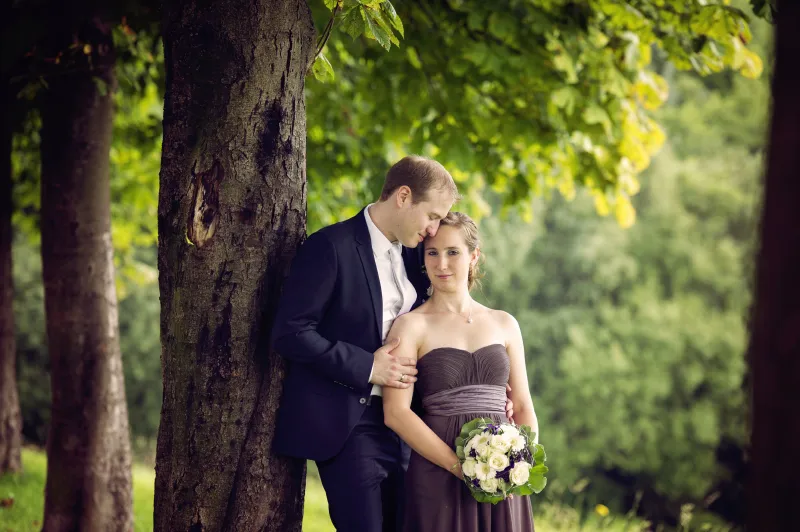
4. tripods
I rarely have tripods with me. However, they may be necessary if you want to work with a second flash or perhaps use your second camera as a photobooth in the evening. Then, of course, they become very interesting. Good tripods are expensive. We are currently experiencing this, as we work with large telephoto lenses in wildlife photography, which place high demands on the load-bearing capacity of the tripods, and we also quickly reach our limits in videography and need special tripod heads, which are of course very expensive.
Apart from that, I always do without a tripod, unlike many photographers who like to work with a mobile monopod or also like to place their camera on a tripod at the wedding ceremony. Of course, this can be practical for longer exposure times, as it prevents camera shake, etc. You may already have some experience here and know whether you are a tripod photographer or - like me - want to work flexibly. All of this has advantages and disadvantages that you will quickly become aware of with a little practice. You should seek advice from a good specialist store so that you can get a tripod that is suitable for your equipment and your requirements.
Our D800 shooting video on the tripod.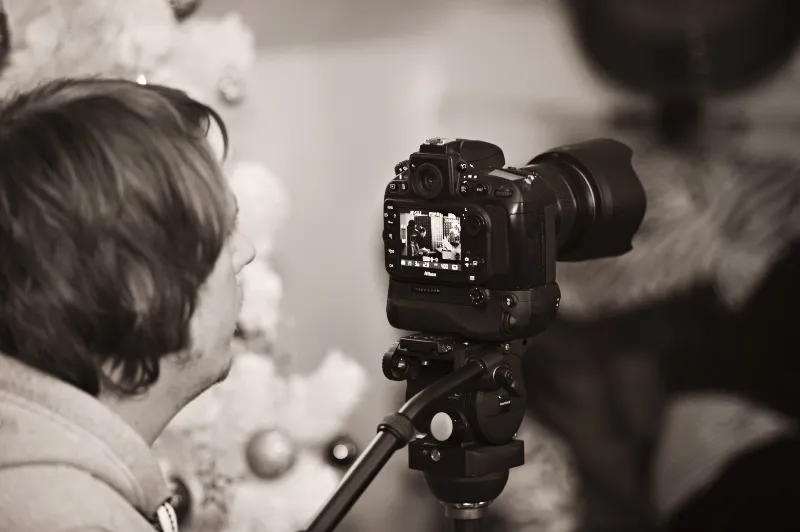
5. memory cards
As already mentioned, it would be great if your camera comes with two memory card slots with the option of double backup on two cards. Always buy enough cards and be on the safe side here. If you are covering a wedding for the whole day, you should expect to take around 2,000 - 3,000 pictures. Depending on the number of megapixels, you should be covered. Whether you use several smaller cards or large cards is a matter of taste.
If you don't have a double backup, I would probably use several small cards. Simply so that you have several parts of the wedding on different cards and don't lose "everything" straight away. I usually use two 64 GB cards (60 MB/s) for a double backup. Unfortunately, when I bought my D4, I also had to buy some Sony XQD cards, which only cover 32 GB each for the time being for cost reasons.
6. data backup
The question here is whether you can always make a double backup with two memory cards in the camera. Then there is only the question of the double backup on your PC at home. I use two external hard disks with double backup (Raid) for this. However, until the pictures are processed and sent to the customer, I also have them backed up twice on my memory cards. Quadruple backup, so to speak. This is of course nonsensical, but I'm being overly cautious here.
If you can't back up the photos twice while you're taking them, I recommend that you always back them up to a laptop or a mobile storage medium on site. It doesn't take long to swap the memory cards and start the copying process. You can continue taking photos in the meantime. Just make sure you choose the right moment so that you don't miss anything important.
7. accessories
Why accessories? I can say from experience that the inclusion of certain objects can be extremely helpful, especially at the beginning of the couple reportage. Especially when the models are not able to move freely in front of the camera or are inhibited. Over time, you will notice when your model still has difficulties with posing and, even when you give instructions, still fidgets nervously with her hands and asks: "Should I do this or should I do that" and constantly wants to move her hands.
At these moments, I always ask: Would you like some pictures with a funny accessory? So far, I've never had a couple not immediately go for it. They immediately rummage in my box, which I always have with me, and eagerly dig out something. And it almost always works.
The couple take out four wooden letters "LOVE" and immediately start making nonsense with them. If not, I encourage them to do so. They immediately have something "in their hands" and can pose much more easily, especially when they are busy with each other and are allowed to get up to mischief. This lightens the mood and makes the couple feel more comfortable. And after a while, other motifs also work without accessories.
Of course, I always try to stock up on accessories or get something "new" from time to time. This also helps if you still have problems keeping the couple occupied with "positions" and motifs for an hour at the beginning. A photographer friend of mine, who doesn't normally do weddings, wrote to me a few weeks ago: "Oh dear, I have another wedding tomorrow and I'm always worried that I'll run out of ideas for the couple photos." Believe me, at some point you will have so many ideas that you can photograph your bridal couple for hours. More on this in the "Couple reportage" tutorial.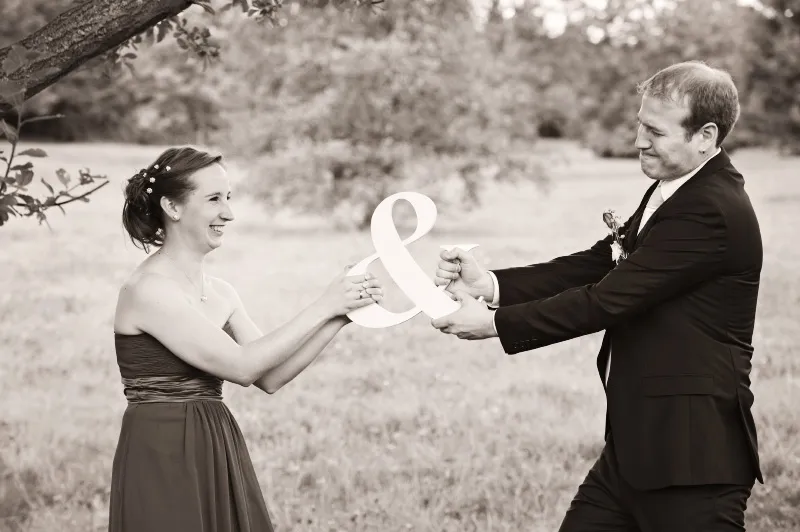
I always have some wooden letters, a wooden board and chalk in my luggage, as well as a few things for the thank you cards that you can incorporate straight away. Be creative and look for some nice things! In addition, a movie clapperboard, which can also be fun to include with a best man, and a white umbrella with "Just married" printed on it. This will also make you shine when a shower comes!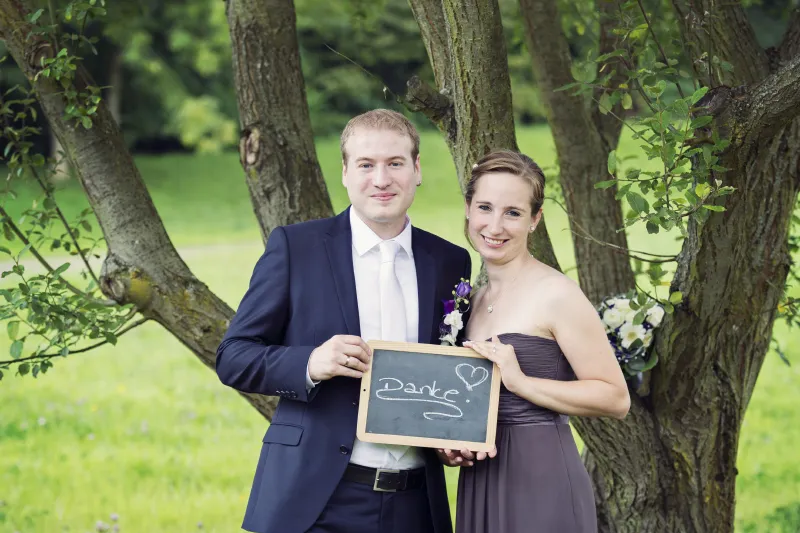
Photobooth equipment can also be used for relaxed group photos. There are so many great ideas that you can incorporate.
8. software
What is often not considered is good image editing software, which of course becomes indispensable over time. If you shoot in JPG format and want to go for more "natural" photography, then this will certainly give you a lot of leeway, but at the latest if you shoot in RAW format and want to add a little extra help to your pictures, you will have to buy the right software at some point. Whether you want to work with Lightroom or Photoshop is of course up to you.
There are so many good programs on the market that you'll be spoiled for choice. My workflow may look very different to yours. I will deal with this topic in more detail in the "Image editing" workshop.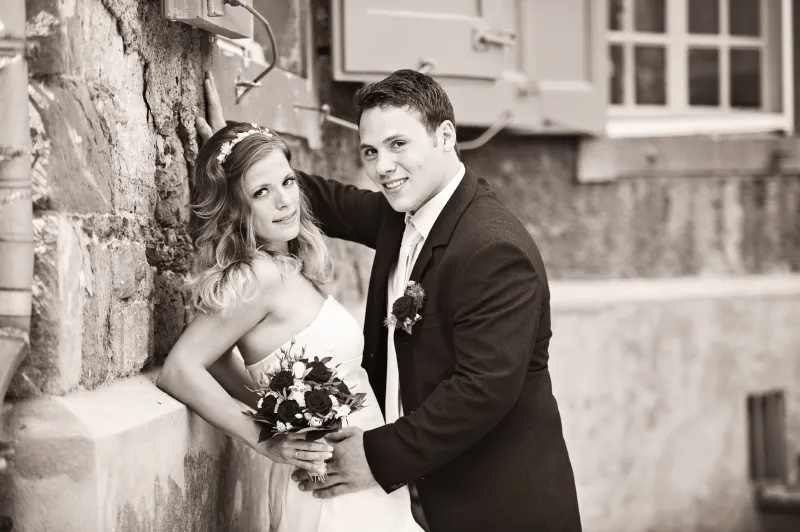
9. miscellaneous
What I always have in my bag is a cleaning kit. If I get caught in a rain shower or something gets on my lens, I can quickly wipe it off. But you should actually always have this in your bag. I either use special damp cleaning cloths or spray in combination with a dry cleaning cloth.
However, I also use this after the moist cleaning wipes so that no residue remains. Otherwise, as already mentioned, I would advise you to always look out for sensor stains. I always notice them because I take photos in the studio.
Sensor spots
In other photographs, this small and light spot would not be noticeable, unless you have a light-colored wall in front of which you are photographing. Nevertheless, it is annoying. I've seen pictures that were covered in sensor spots, which the photographer apparently didn't even notice. How dirty the sensor of our cameras really is always becomes clear in HDR shots. Due to the corresponding processing, every sensor spot, no matter how small, immediately becomes very noticeable. Sensor spots appear that you would otherwise not see at all!
I therefore recommend that you examine your images carefully and have them professionally cleaned if necessary. I always advise against trying to do it yourself. I pay around 30.00 euros for an inspection and cleaning of the camera at the Nikon Service Point. That's a price you can definitely afford. I do this very regularly. Of course you can also try it yourself, but I'm always afraid that I'll break more than I can clean.
Take care of your equipment and remember to clean it regularly to avoid sensor stains.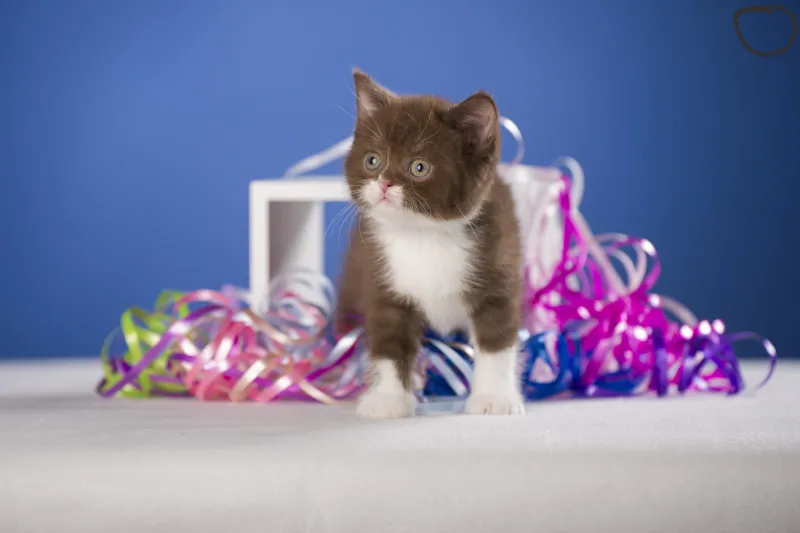
Furthermore, I always have a transparent powder and a brush in my backpack so that I can powder my bride and groom again if necessary. The brides are usually well made up and have their make-up done by a professional make-up artist. The make-up often lasts the whole day. However, if it is very warm, shiny spots may appear on the face. And the groom also has to help out if he "shines". Save yourself the time and effort of having to retouch and edit the pictures afterwards by taking a minute to pull out your brush and powder. And another tip ... If the best man laughs at the poor groom because he is being "made up", then he is the next victim! I always see it as a verbal application that someone else wants to be made up.
So, that's the most important information about wedding photographer equipment for now. Of course, I always get the question from friends and clients: Should I buy camera XY or should I buy lens XY or Z? You can't give a blanket yes or no answer to all these questions. First of all, I always have to compare the data and of course I haven't tested every camera and can't say much about them.
But nowadays there are so many good specialist stores that can give you good advice on this, that know all the current models on the market and are certainly a much better place to go. This is also always an aspect to consider, especially as many Nikon photographers will only ever sell you their equipment and Canon photographers often do the same. Get advice from someone who is really neutral in their approach.
Also: Think about yourself. You often can't drink or eat for a long time. Make sure you have everything. I always have a bottle of water, glucose or a muesli bar, painkillers and blister plasters in my luggage. Better take precautions!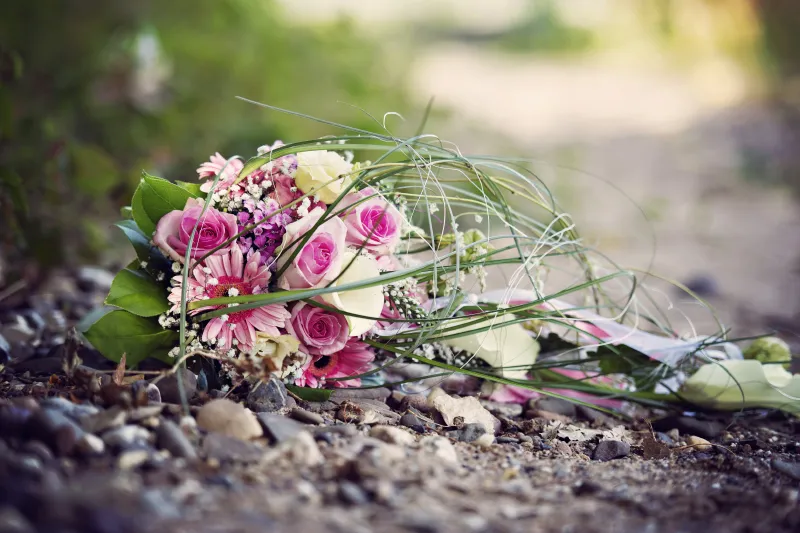
Last but not least: Don't sell old equipment
Never sell an old camera because, as already mentioned, it has to serve as a backup camera. A second camera is actually indispensable at weddings. It hurts when you need the money from selling the camera or lenses to buy a new one. However, you should always be sure that you will never need the old equipment again. Otherwise you will really regret it. It's better to save a little longer, even if it's difficult. This actually applies to everything, cameras, lenses, flashes and memory cards. Who knows what will change, who knows whether you will need them again. For example, I sold all my SD memory cards when I switched to the D3s, sure that I would never need them again. When the D800 moved in, I was proven wrong.
Apart from that, I'm already looking forward to the next part of the series and hope that this tutorial has helped you. I would like to take this opportunity to thank you for the encouragement for this series, the kind emails and of course your attention to this long tutorial.
Nicole Schick